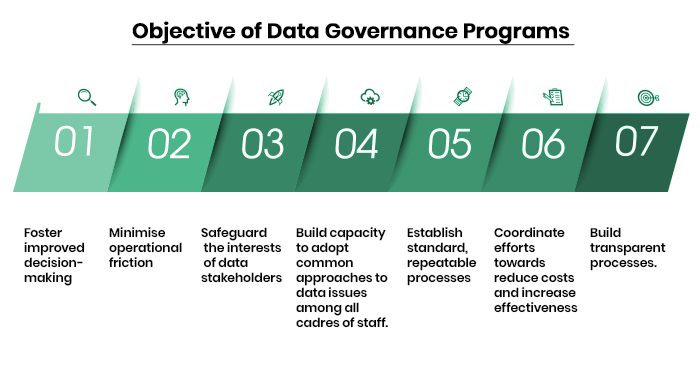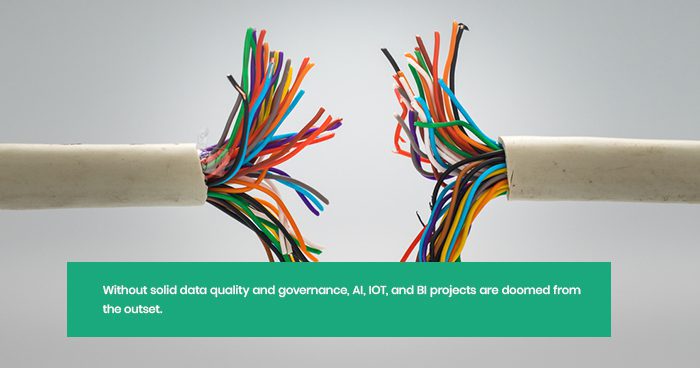Ensuring that investments in digital transformation achieve results requires the development and effective implementation of a robust data governance framework to support the trusted use of data-driven platforms and services.
Often ignored at the expense of more exciting and immediate business initiatives, Data governance lies at the heart and success of every successful digital transformation journey.
But for burning global discussions on Data Privacy, security and quality, Data Governance would perhaps have been a byword in current-day corporate circles.
Top management across organisations have realised the criticality of data, and it’s a prerequisite for digital transformation. Data and its analysis is the driving force for new revenue streams. However, the data must be readily available, high-quality, and relevant to activate this driving force. In its simplest terms, Data Governance ensures the existence of these attributes that will enable the analysed data to create value.
Data processing and cleanup can consume more than half of an analytics team’s time, limiting scalability and frustrating employees. Indeed, employees’ productivity across the organisation can suffer; respondents to the McKinsey 2019 Global Data Transformation Survey reported that an average of 30 per cent of their working hours was spent on non-value-adding tasks due to poor data quality and availability.
Simply put, Data Governance can be defined as a system of decision rights and accountabilities for information-related processes, which are executed according to agreed models which describe who can take what actions with what information and when, under what circumstances, using what methods.
While the most common objective of Data Governance programs is to standardise data definitions across an enterprise, below are other justifiable reasons for an executive to focus and pay attention to Data Governance as a burning emerging topic.
Addressing Some Business Drivers for Data Governance
Having identified Data governance as a “SYSTEM of decisions, rights and accountabilities……”. The need to create this system should be driven by Top management’s desire to deliver on its mandate.
Risk Reduction
Data governance initiatives improve data security by defining ownership and responsibility for data. Improved data security by consequence will assure improved physical protection of the data asset and enhance the business’s reputation as a company that customers, suppliers, and stakeholders can trust. Data governance plays a vital role in regulatory compliance. Currently, compliance with the General Data Protection Regulation (GDPR), and the Nigerian Data Protection Regulation (NDPR), has become a key risk consideration for organisations in light of sanctions being meted out to erring organisations. Data governance reduces the exposure to non-compliance risk by providing policies and processes to control confidential information and Personal Data, thus avoiding the risk of penalties and sanctions.
Highlighting the risks and potential costs of non-compliance is a massive motivator for investing in data governance.
Operational Efficiency
The benefit of Data governance is making data more accessible to those who need to make decisions and take action. Clean, up-to-date, good quality, well-governed data assures qualitative decision-making, leading to a faster turnaround of answers and accurate reporting. Data governance also establishes uniformity with data definitions and business terms so everyone can speak the same language and compare like with like.
Businesses today have an ever-increasing number of data sources, both inside and outside the organisation. Simplified business data integration streamlines standard processes for continuous business monitoring to enable more data-based analytics. The quicker businesses can integrate reliable data into their decision making, the faster they’ll be able to make more intelligent decisions. Data growth across industries is at an exponential high, and the sooner organisations reign in and govern the volume of data collected, the better prepared they will be. Perhaps, the organisation’s increasing interest in data cleanup projects is a testament to an increasing realisation of the need for data to drive operational efficiency, howbeit putting data cleanup ahead of establishing data governance.
So, what should be top of mind for top executives now regarding Data Governance?
1. Establishing a data governance program. NOT data cleanup/data analysis project etc. this must commence with;
a. Clearly defining and communicating an outline of what data governance means to the organisation will cascade down and impact the salient actions of all stakeholders involved.
b. Identifying the relevant Focus Area(s) of Data Governance for the organisation (This will determine which rules and concerns stakeholders will address. It will influence the mix of data stakeholders involved in data-related decisions and actions, as well as the amount of effort required of stakeholders.)
c. You demonstrate and communicate the value of governance to ALL stakeholders across the organisation per identified focus Area. Particularly (and where possible) associating with the three universal value drivers. It is also beneficial to integrate data governance with primary transformation themes, linking them directly to continuing transformation efforts that already have Top Mgt attention, such as digitisation, omnichannel enablement, or enterprise-resource-planning modernisation. These transformation efforts will ride on data availability and quality and simplify Top mgt buy-in. Rather than a siloed effort at institutionalising governance, these transformation initiatives will shift data responsibility and governance toward product teams, ensuring governance practices are deeply integrated at the point of production and consumption.
2. Preparing a roadmap of the Data Governance journey, clearly articulating the WHO, WHAT, WHEN, HOW, WHY, and the role of stakeholders.
3. Planning and providing funding for the data governance program. A budget should be planned for;
a. The initial design and implementation of the data governance program
b. Ongoing Data governance / Stewardship / Compliance / Access Management efforts
c. Ongoing Data Stewardship / Data Quality efforts
d. Recommended projects and efforts that come from governance led issue analysis
*Often undermined and external to budget provisions (howbeit integral to success or failure of the data governance implementation).
4. Designing the Data governance program using an established framework tailored to the organisation’s unique circumstances, leveraging external professional expertise or internal know-how (if/where available). This will involve extensive engagement of stakeholders’ needs and requirements, organisational structure and maturity, organisation vision and strategy.
a. This may involve the creation of functions such as a central data management office (DMO). This function may be led by a chief data officer (CDO). This role will have the responsibility of driving a targeted data strategy and will be supported by governance leaders to set the overall direction and standards
b. governance roles should be organised by data domain, i.e. where the day-to-day work is done
c. Organisations may consider the constitution of a data council to bring domain leaders and the DMO together to connect the data strategy and priorities to the corporate strategy, approve funding, and address issues.
*However, these will be determined based on organisational peculiarities.
5. Deploying the governance program via a publicised rollout of developed policies, procedures, processes (automation and operationalisation of these processes where possible), provision of requisite training on the expectation of various roles in the program and all staff of the organisation and a sustained awareness campaign on the benefit of the program to the organisation. Where resistance/hesitance exists, immediate change management interventions should be employed at ALL/ANY level to ensure successful deployment.
* Implementation efforts are best executed via external professional support, after which organisations are better able to operationalise and continuously improve on established processes, procedures, policies, roles and outcomes.
Upon implementing the governance program, what next for top management to do? Govern! These established processes, procedures, metrics must now be used to carry out the governance responsibilities (risk optimisation, benefits realisation, resource optimisation) via mandating monitoring, measuring, and reporting by the responsible stakeholders in the Data governance program.
Written by:

Oludiji Lana
Enterprise Solution Architect



